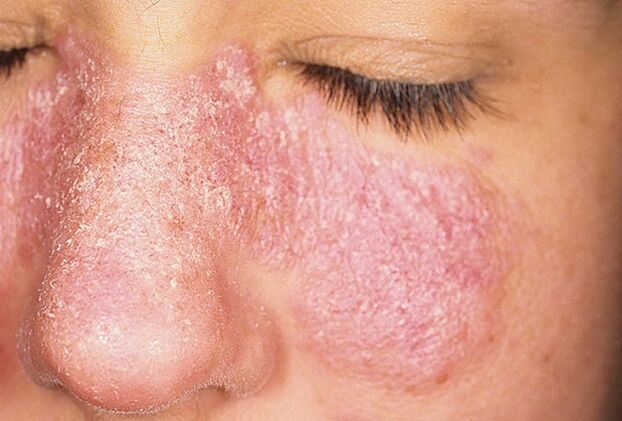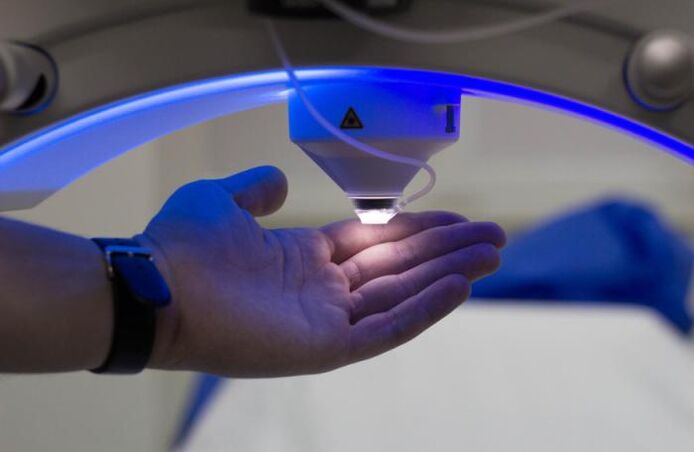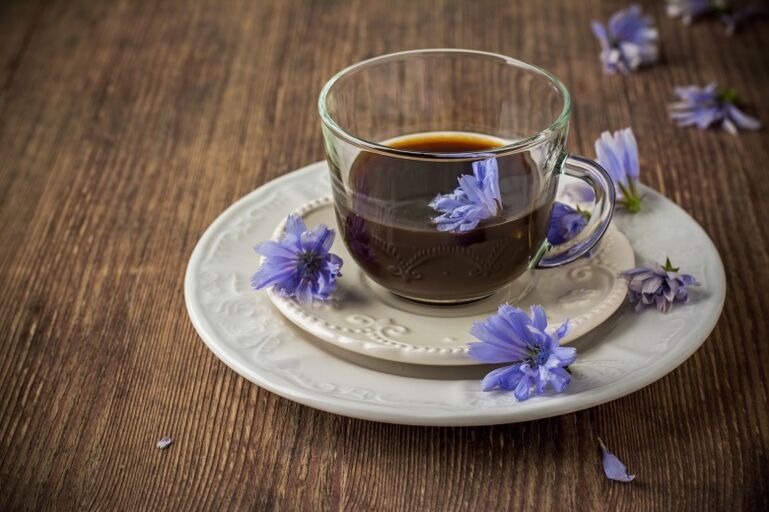Tired of fighting psoriasis on your face? Don't know what can cause it to appear and how to accurately recognize this disease? Would you like to know traditional therapeutic recipes? Are you looking for information on modern hardware techniques to combat this disease? You will find this and other interesting information in our article!
What is psoriasis on the face?

An autoimmune disease of a non-infectious nature, manifested in severe redness of the skin with the appearance of small scales (papules) on its surface, which gradually increase in size and merge with each other, is called psoriasis. In this case, the person feels itching and discomfort associated with disgust from others who do not understand that this disease is not transmitted through daily contact.
It is impossible to reliably identify the cause of this insidious disease even with the modern level of development of medicine. It is believed that the disease is caused by a hereditary factor, disorders of the immune or endocrine system, disorders of lipid metabolism and constant stressful situations.
Most often, the localization of psoriasis on the face is the area around the eyes and temples, eyebrows, nasolabial folds and border zones near the scalp.
There are 2 types of psoriasis: vulgar (the most common) and seborrheic. Unlike seborrheic vulgaris, it is considered a more complex form of the disease, as it is characterized by the appearance of particularly dense and large papules, as well as scales covered with a layer of yellowish sebum. The common belief that seborrhea (increased sebum production) is the cause of the development of this form of psoriasis is incorrect.
The course of the disease is accompanied by periods of remission (disappearance of symptoms) and relapses (symptoms that reappear after a certain period of time).
Characteristic signs of psoriasis
To correctly recognize and determine the presence of psoriasis and not some other dermatological problem, you need to know the following main symptoms of this disease.
- If you pass the nail plate over plaques with scales that appear on the surface of the skin, you will notice a subsequent increase in peeling in this area. This mark is called stearin stain due to its resemblance to a drop of frozen wax which, when touched with a finger, forms many peeling plaques.
- When carefully cleansing the skin from the scales that have appeared, a thin film will be visible on the surface of the epidermis, colored bright red. This feature is called terminal film.
- After removing the terminal film from the skin surface by scraping, multiple small pinpoint hemorrhages in the form of small drops are observed. This bleeding is caused by the proximity of the capillaries to the epidermis, which are easily damaged during the disease. This phenomenon is called blood dew.
Plaques and papules in psoriasis grow, rapidly increasing in size. By uniting, they form single conglomerates that disfigure the affected area of the face. Do not comb or remove scabs from the affected skin areas, as this may cause scarring.
Stages of psoriasis
There are 3 main stages of the clinical manifestation of psoriasis on the skin of the face:
- Progressive. It is characterized by an increase in the size of existing plaques and their merging into one place with the active appearance of new papules, as well as a bright red rash with a flaky structure against a background of severe itching. When you scratch, new rashes appear.
- Stationary. Its peculiarity is the cessation of the growth of papules with a notable decrease in desquamation. Existing plaques acquire a blue tint, and itching becomes less pronounced.
- Regressive. This stage is associated with masking all symptoms of the disease. All manifestations of psoriasis become almost invisible. Scaling and itching disappear completely, papules and plaques begin to resolve.
Skin care recommendations for psoriasis
The right thing to do in such a situation would be to immediately contact a specialist, a dermatologist, who will carry out a comprehensive examination of the body, identify the extent of skin damage, prescribe professional treatment, and also explain how to properly care for it. skin affected by psoriasis. If for some reason you cannot see a doctor now, listen to the following tips and recommendations.
- Use cosmetic cleansing and facial care products designed for sensitive skin to prevent injury and subsequent exacerbation of the disease.
- Avoid vigorously scrubbing the affected skin surface after washing. It is best to dry these areas using a paper towel, gently applying it to the problem areas.
- It is worth temporarily stopping (before visiting a doctor) from using any cosmetics, including decorative ones.
- You should not use scrubs and peeling compounds, which can provoke inflammatory reactions and worsen the situation.
- Men who use razors should replace them with an electric razor, which is less harmful to the surface of the epidermis.
Possible treatment options for the disease
We present the treatment method for informational and general purposes only. Don't self-medicate! Be sure to contact a specialist to receive the individual and comprehensive therapy that is right for you!
After examining and evaluating the nature of the disease, a dermatologist will select the best treatment option for you, which may include:
- Medicines for internal use (tablets, injections).
- Ointments, emulsions and appropriate compositions of cosmetic vegetable oils for external use.
- All types of physiotherapeutic procedures using special devices and instruments.
- Properly selected diet and lifestyle recommendations.
- Products for household use (lotions, ointments).
Drugs used for internal treatment
As a rule, such a disease involves taking the following drugs: cytostatics, immunosuppressants, glucocorticosteroids, biologically active drugs.
Systemic therapy can be prescribed in the form of taking pills or injections of drugs that act specifically and comprehensively and also relieve the sensation of itching.
As preparations for external use, naphthalene and salicylic ointments, as well as mixtures containing corticosteroids, are often prescribed.
Moisturizing and vitamin compositions are used for general toning and strengthening local immunity of the skin.
Physiotherapy treatments

- Ultraviolet lamps, the action of which is based on the effect of UV rays, which consists in slowing down the growth of pathological cells of the epidermis and the general improvement of the skin. The method proved to be quite effective.
- Phototherapy, carried out under the supervision of a specialist, is based on exposure to certain frequencies of UV radiation. This method has many positive reviews.
- The excimer laser, used in specialized clinics, is considered the most modern and effective device that helps to actively fight psoriasis.
Dietary recommendations
It is recommended to eat a large amount of vegetables, fruits, berries, herbs, fish, lean meat, dairy products and cereals.
The ban included fatty, spicy, spicy, smoked, fried foods and dishes, as well as sweets, baked goods, nuts and whole milk.
During the treatment period, smoking and drinking alcoholic beverages are strictly prohibited.
Ointments and creams used
To treat psoriasis on the face, mainly non-hormonal ointments and creams are used, as they are considered the safest. As an example, we can cite the most common and frequently prescribed ointments based on fat, essential oils and plant extracts, the use of which must fully comply with the instructions. They give temporary results and after long-term use have an addictive effect.
Popular recipes
By making an effort to find and select the necessary components for preparing homemade ointments, you can achieve an effective treatment against psoriasis, which will have a therapeutic effect after 4 weeks of regular use.
Apply these compounds exclusively to clean, dry skin in a small amount and in a thin layer.
| Recipe number | Components in the composition, quantity | Production notes |
|---|---|---|
| 1 |
|
After mixing all the components of the composition, it is stored in a dark, cool place for 15 days. |
| 2 |
|
All ingredients are thoroughly mixed and infused in a cool, dark place for 3 days. |
| 3 |
|
The components are thoroughly mixed and stored in a dark place for 3 days. |
Treatment of psoriasis with Dead Sea salt has a good effect, thanks to the special composition of its minerals, which easily penetrate the epidermis, providing a healing, anti-inflammatory and astringent (drying) effect. It is recommended to add this salt to thermal water and spray problem areas of the epidermis with this composition several times a day.
Natural essential oils of coconut, borage, juniper, evening primrose, lavender, jojoba, tamanu, sea buckthorn have shown excellent results when used regularly.
Compositions for internal use

- A tincture of Chinese lemongrass fruits, consumed 20-30 drops before meals 3 times a day, will help the body actively fight adverse environmental factors.
- It is recommended to drink a decoction of common chicory ¼ cup 4 times a day. Improves immunity and has a calming effect.
- Applications based on Kalanchoe pulp (the leaves are ground to form a paste) perfectly cleanse the skin of plaques and papules. Using a patch, the mixture is applied to the affected areas of the skin and left for 4 hours.
- Juice of celandine (fresh plant) is mixed with calendula infusion in a 1: 1 ratio. Once a day, apply this mixture to problem areas.
Use folk remedies, but don't forget to consult your doctor!
























